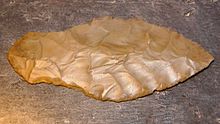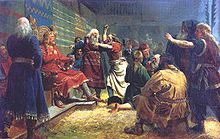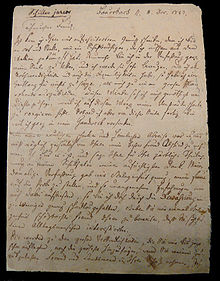Source (history)
As a source is known in the science of history - after the much-quoted definition Paul Kirn - "all texts, objects or facts from which knowledge of the past can be obtained." The research interests of the respective historian are decisive for the definition of a source . From this and from the internal and external form of the sources, there are possibilities for dividing sources into source types. The sources are differentiated from secondary literature (in technical terms mostly referred to as representations ), i.e. modern specialist literature. Sources serve the reconstruction of historical facts and the historical scientific argumentation ("evidence"). When dealing critically with historical representations, historians also use methods of deconstruction in order to recognize the specific perspective of the source on the facts to be researched.
The term “source situation” refers to the totality of available sources on a specific topic and their status. For historians, the methodically correct registration of the source situation is important in order to arrive at an appropriate assessment of a situation. The source criticism was, among others, Johann Gustav Droysen and Barthold Georg Niebuhr introduced into the science of history and of Ernst Bernheim developed. First of all, it is about the authenticity of a source and secondly about its informative value.
Delimitations
The secondary literature , which is consulted as scientific specialist literature, must be separated from the sources (e.g. an ancient or medieval text) . The boundaries between sources and secondary literature can be blurred under certain circumstances, because what is a source or secondary literature depends on the research interest or the intention of the researcher. An ancient historian who is interested in the political system of ancient Rome is the work itself, Roman constitutional law of Theodor Mommsen read as literature. Although it is very old and does not represent the modern state of research, it is still important secondary literature. From the perspective of this ancient historian, Mommsen is a colleague. If, however, a historian of science reads Roman constitutional law because he is researching the work of Theodor Mommsen (or more generally about the ancient studies of the 19th century), then Roman constitutional law serves as the source. For the science historian, Mommsen is an object of research.
Such a distinction is not the rule, however: With regard to the evaluation of ancient, medieval or early modern texts, these serve as sources for the interpretation of which modern specialist literature (secondary literature) is used.
Historical sources are not to be equated with comments in a scientific paper. A note can, however, refer to a source.
Classifications of sources
The assignment of a source to a source group is sometimes difficult, since the assignment mostly depends on the question of a historian. Therefore, a certain type of text cannot generally be classified in a group, even if, for example, most invoices are used as residual sources (and not as traditional sources).
Outer shape


A basic distinction is made between factual sources, image sources, abstract sources and text sources, although the classifications and names in individual textbooks can be different.
Material sources or “tangible relics” are, for example, buildings and works of art, coins, or objects from the world of work and everyday life, such as an arrowhead or a plow. These sources are often dealt with in related and sub-disciplines of historical science, such as archeology or the individual historical auxiliary sciences .
Image sources are profane or artistic representations. A painting is also a concrete object, but the image on it has its own value. Not only art history, but also the history of politics, society and mentality as well as other historical research directions now use image sources and figurative art as sources for statements about social reality. In addition to the actual individual image sources such as paintings and photographs, there are also audio and video sources in the modern era. The various image, sound and film sources can be roughly divided into documentary and narrative-fictional sources. The more complex the structure and the more polysemic the type of source in question (movie, TV series, computer game, etc.), the more necessary a theoretical discussion in advance of its historical evaluation and analysis.
Abstract sources and “facts” or “abstract remains” are not tangible, but can be experienced through social reality. Ahasver von Brandt defines them as surviving or traditional institutions. For example, from the Malagasy language, one can see that the ancestors of today's residents of Madagascar do not come from Africa, but from Asia. Another abstract source is a folk festival that has long been celebrated in a village. Even if there is no written source for its creation, the existence of the festival proves that the festival exists and that it must have arisen at some point. Similar to the oral testimony of a contemporary witness , only the written observation of a researcher can be used as a source in science.
Text sources are originally bound to a writing material, but can be edited separately. The text sources are the most important and mostly meaningful sources, at least from the perspective of historians. They usually include letters, files, newspapers , pamphlets and literary works. Sometimes one also speaks of the narrative sources. Sources originally transmitted orally or based on memories, which are based on oral statements and were only later recorded in writing, are problematic.
Proximity to historical events
Sources can also be judged according to the temporal, personal and other proximity of the source author to the relevant event. It makes a difference whether you describe an event on the same day in your diary or years later in your memoir. Likewise, it is not essential that sources written down earlier are generally more reliable than those written later; rather, it depends on the quality of the sources on which the respective author relied or whether he was a reliable (as little subjective) reporter from his own perspective.
Primary source and secondary source
A secondary source is used to find out something about the content of a (lost) primary source. Stefan Jordan: "A secondary source is the analogous reproduction of one source in another source." The assessment as a primary or secondary source is closely related to the specific transmission situation. If there is no secondary source in this context, this differentiation is superfluous and one simply speaks of a source.
In this context, it is of great importance to be aware of the respective chances of transmission and incidents of transmission: For example, some historical works (especially from antiquity, but also from the Middle Ages) and documents (e.g. from the early Middle Ages ) are often not preserved and can not be therefore, such periods appear to have fewer sources than they originally were.
Tradition and remnant
This classification, which originally came from Droysen (as a three-way division into “remains”, “sources” and “monuments”) and was modified by Bernheim , is called
- Remnants: “Everything that is immediately left over from the events”, and
- Tradition: "Everything that is left of the events passed through and reproduced through human perception."
In a traditional source, someone reports on something while the remainder of some other act remains. A source of tradition is, for example, a speech, a letter, an old work of history that report on the past. The author intended to inform other people about something. A remnant is, for example, an invoice that arose through business transactions between two merchants. It is used to document a business transaction, for which it was issued. But it can serve as a source for a later historian.
The remnant source is generally considered to be more reliable than the traditional source, as a speaker, letter writer or historian can be wrong or even want to deceive. Nevertheless, to stay with the example, the invoice could already have been issued incorrectly or with fraudulent intent. In any case, the remnant was at least not made long after the event, while traditional sources may report something long in the past. According to von Brandt, the group of residual sources includes all material sources, such as buildings or physical remains.
The classification can also depend on the historian's question. A letter from person A to person B informs about an event. With regard to the event, the letter is a source of tradition. On the other hand, the letter itself is a remnant of the fact that person A gave person B a particular account of a particular event at a particular point in time. In other words: if the historian is interested in the event, then the letter is a source of tradition; if he is interested in the relationship between A and B, it is a remnant.
For such reasons, according to von Brandt, the breakdown into remnant and tradition is “theoretically fairly clear”, but does not allow “ absolute systematics”.
Descriptive and normative sources
Most sources should be descriptive and describe a reality as perceived by the writer. In practice, however, a descriptive source is difficult to identify because - according to the definition - it must allow a "value-free consideration" as possible. Normative sources, on the other hand, such as a legal text or a political treatise, say how something should be or be done. Whether the norms were actually adhered to in reality is another matter. This problem is added to the more general ones when assessing and using a normative source.
Typologies
Typologies of sources endeavor to classify (written) sources according to their text genre, literary genre and similar categories. The medievalist RC van Caeneghem, for example, divides the medieval sources into:
- Narrative texts in the true sense of the word, including: compendia , chronicles , church histories , national histories , annals , gesta , biographies , hagiographies
- Documents (but also Deperdita ) and files , collections of the same such as office rolls and formula books
- "Fiscal and socio-economic documents" such as tax books, university registers and necrologists
The last collective printout has an overarching character, as do the ego documents (self-reports). In addition to letters, pocket calendars and diaries (i.e. remains), the latter also include traditional sources such as memoirs.
The typological classification is often directly related to the corresponding auxiliary science : coins belong to numismatics , fonts (as such) to palaeography , documents are dealt with by diplomats , inscriptions by epigraphy , seals by sphragistics .
Work with sources
In order for a historian to be able to consider a source, it must be indexed in an archive or a similar institution. The selection and interpretation of a source, and ultimately its use in your own work, must follow certain rules.
Development
Developing source material means identifying the material, getting an overview and enabling access. By archiving, registering, etc., it is possible for the person making the inquiry and other interested parties to use the material, namely to search for it in a targeted manner and finally to quote from it.
Handling in research and presentation

A historian must have certain considerations before using a source. The rules of source criticism include, for example, the question of whether the source is genuine, who made it, etc. Source studies, part of the historical auxiliary sciences, deals extensively with such questions.
A source must be used and classified in connection with other sources. A source citation in a representation must not be satisfied with the mere (selected) source text; it must be accompanied by factual commentary and interpretation.
Evidence in a scientific paper
Source citations or statements that are based on a source must be substantiated in a scientific paper , with precise information about where the source can be found, i.e. in which source edition or which archive and on which page or text passage, for example of a book. The annotation apparatus is usually used for this .
The following is an example from a book by Daniel Koerfer:
- Bibliography
- Archive of the Ludwig Erhard Foundation, Bonn (AdLES)
- Ludwig Erhard estate
- I 1) 3 Correspondence with Konrad Adenauer 1953
- I 1) 4 Correspondence with Konrad Adenauer 1956 (...)
- -NE No. 1502: Speech manuscript Strasbourg, November 20, 1962 (...)
- Archive of the Ludwig Erhard Foundation, Bonn (AdLES)
Depending on the customs of the individual sub-discipline or depending on the author, the sources and bibliographies show greater differences. Daniel Koerfer, for example, only mentions unpublished sources and everything else under the "bibliography" in his list of sources. Nils Havemann ( Fußball unterm Hakenkreuz , Bonn 2005) first mentions the "unprinted sources" and then the "printed" ones, which he includes not only source editions, but also memoirs, contemporary writings and yearbooks. The latter because it was used as a source, not as secondary literature. Havemann then names the journals viewed (with maturity) and only then the “representations” (the secondary literature). The comments are either as footnotes on each page or only at the end of the paper in the form of endnotes . In addition to the annotation apparatus, the sources are listed separately and summarized in a bibliography. It makes sense to distinguish between published and unpublished sources. Only then is the secondary literature used listed in another section.
Ultimately, it is about making it easier for the reader to find the sources used. The level of detail in the list of sources depends in part on the organization of the archive , or on whether information has already been given in the notes.
Quotes
- "Writing history that is not based on sources is not a science." ( Leo Santifaller )
- “From a precise insight into the nature of the sources, various statements about their specific value follow as if by themselves (type, richness and reliability of the information, special aspects). The typology intends to sharpen the understanding, but not to draw sharp boundaries between the different types of sources, since in reality such often do not exist. ”(RC van Caeneghem)
- "Sources only speak when you ask them, and they speak one way or another, depending on how you ask them." ( Volker Sellin )
literature
- Friedrich Beck , Eckart Henning (Hrsg.): The archival sources. With an introduction to the historical auxiliary sciences . (= University paperbacks ). 4th revised edition. Böhlau, Cologne a. a. 2004, ISBN 3-8252-8273-2 .
- Ahasver von Brandt : tool of the historian. An introduction to the historical auxiliary sciences. (= Urban paperbacks. 33). 11th edition. Kohlhammer, Stuttgart a. a. 1986, ISBN 3-17-009340-1 . (first 1958)
- Paul Kirn: Introduction to History . Continued by Joachim Leuschner . 5th edition. de Gruyter, Berlin 1968. (first 1947)
- Michael Maurer (Ed.): Outline of the historical sciences . Volume 4: Sources . (= Universal library 17030). Reclam, Ditzingen 2002, ISBN 3-15-017030-3 .
- Otto Gerhard Oexle : What is a historical source ?. In: legal history. Journal of the Max Planck Institute for European Legal History 4 (2004), pp. 165–186 ( online ).
Web links
- Brief overview of the University of Konstanz
- Stefan Jordan: Sources' right of veto . Version: 1.0, In: Docupedia Contemporary History . February 11, 2010.
Remarks
- ^ Paul Kirn: Introduction to the science of history. continued by Joachim Leuschner. 5th edition. De Gruyter, Berlin 1968, p. 29.
- ↑ Peter Wolf: Dingliche relicts. In: Michael Maurer (Ed.): Outline of the historical sciences . Volume 4: Sources. Reclam, Ditzingen 2002, pp. 126-144.
- ^ Václav Faltus: Fiction , Film Theory and History. A contribution to the methodology of contemporary history. Erlangen 2020, http://d-nb.info/1203375433 , p. 23ff.
- ^ Volker Sellin: Introduction to the science of history . Vandenhoeck & Ruprecht, Göttingen 2005, pp. 45–47.
- ↑ a b Ahasver von Brandt: Tool of the historian. An introduction to the historical auxiliary sciences. 11th edition. Kohlhammer, Stuttgart 1986, p. 56.
- ↑ Johannes Fried : The veil of memory. Principles of a historical memory . CH Beck, Munich 2004.
- ↑ Stefan Jordan: Introduction to the Study of History. Reclam, Stuttgart 2005, p. 57.
- ↑ In the formulations of: Ahasver von Brandt: Tool of the Historian. An introduction to the historical auxiliary sciences. 11th edition. Kohlhammer, Stuttgart 1986, p. 52.
- ↑ Ahasver von Brandt: Tool of the historian. An introduction to the historical auxiliary sciences. 11th edition. Kohlhammer, Stuttgart 1986, p. 53.
- ↑ Ahasver von Brandt: Tool of the historian. An introduction to the historical auxiliary sciences. 11th edition. Kohlhammer, Stuttgart 1986, p. 54 (emphasis in the original).
- ↑ RC van Caeneghem, FL Ganshof: Brief source study of the Western European Middle Ages. A typological, historical and bibliographical introduction. Vandenhoeck & Ruprecht, Göttingen 1964, according to the table of contents.
- ↑ See Eckart Henning: Self-testimonials. In: Friedrich Beck, Eckhart Henning: The archival sources. With an introduction to the historical auxiliary sciences , 4th edition. Böhlau Verlag, Cologne / Weimar / Vienna 2004, pp. 119–127.
- ^ Daniel Koerfer: Struggle for the Chancellery. Erhard and Adenauer. 2nd Edition. Berlin 1998 (Stuttgart 1987), p. 927.
- ↑ Quoted from Eckart Henning : Introduction. In: Friedrich Beck, Eckhart Henning: The archival sources. With an introduction to the historical auxiliary sciences. 4th edition. Böhlau Verlag, Cologne / Weimar / Vienna 2004, p. 2.
- ↑ RC van Caeneghem, FL Ganshof: Brief source study of the Western European Middle Ages. A typological, historical and bibliographical introduction. Vandenhoeck & Ruprecht, Göttingen 1964, p. 12.
- ^ Volker Sellin: Introduction to the science of history . Vandenhoeck & Ruprecht, Göttingen 2005, p. 48.

